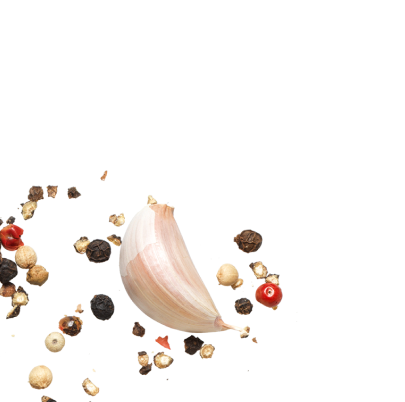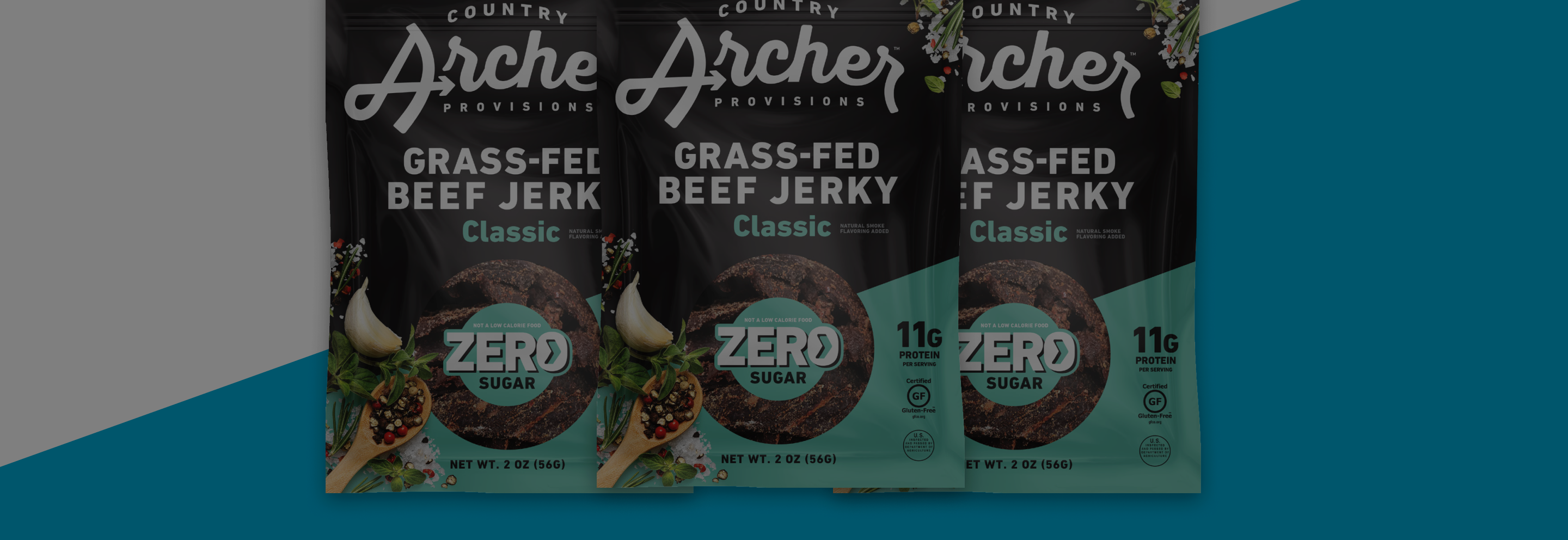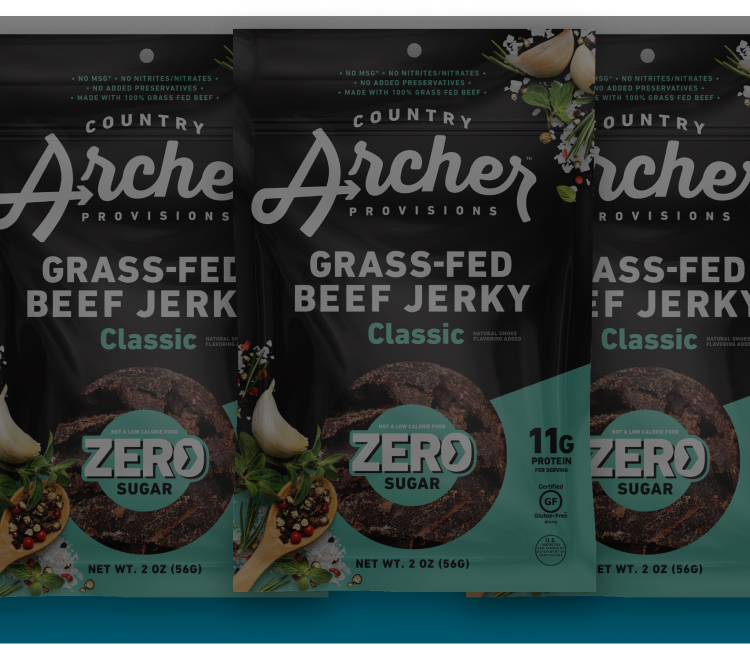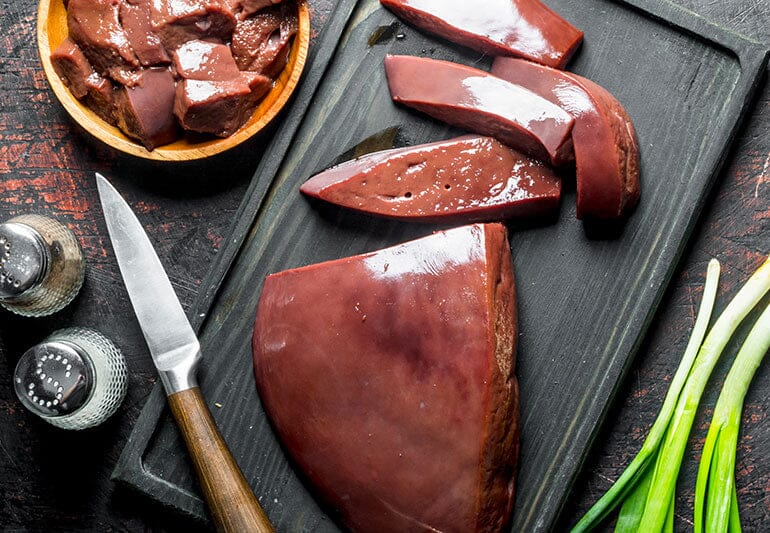Beef is a common addition to most dinner tables. More and more people are “waking up” to the fact that not all beef is made equal, and understanding just what they are eating goes back to taking careful note of where their beef comes from. In modern times, there are three main types of beef that you can learn about. These are grain-fed beef, grass-fed beef, and grass-fed-and-finished beef. Here at Country Archer, we only use grass-fed-and-finished beef in our high-quality beef jerky.

What is grain-fed beef?
This is the most common kind of beef that you’ll find in stores. While they will start out on a grass-fed diet, they will be moved at a much younger age to a feedlot. On this feedlot, they’ll receive grain-based feeds from soy and corn. Most are kept in small stalls with little space to move. This allows them to produce more and to help the fatten-up faster, allowing for a faster slaughter.
Their nutritional value is very close to other kinds of beef. They contain many nutrients and minerals. The main difference is that they have a higher fatty acid profile since their diets are fattier. This can be good for those who are searching specifically for foods with a high fatty acid profile.
As far as flavor goes, the fat content factors in here, too. The marbling of lean beef with its higher fat content offers it a “juicy” taste that many look for in burgers, for example. For those who are looking for that rich, fatty taste, this is the most common choice.
The animal welfare of grain-fed beef is often far below grass-fed beef. Since they are moved onto feedlots very young, fattened up with rich, large diets, and confined to increase their weight, their welfare isn’t protected. While there are exceptions to this, grain-fed beef has a low animal welfare score.
This is where things get a bit tricky, depending on your approach. Technically, grain-fed beef has a lower environmental impact from a “front-on” point of view. Since they are slaughtered younger, their potential for negative environmental impact is lower, mostly through resource use and methane production. However, they do have a negative impact in that their manure isn’t as rich or as restorative, since they rely on soy and corn in their food.
Typically, grain-fed beef is cheaper than other options, both to produce, and sell. That’s part of why it’s as common as it is.

What is grass-fed beef?
This is very similar in a lot of details that we talked about above. The main difference in this grass-fed beef is that they don’t receive supplemented diets of grain feed. They will eat grass, hay, and more. They take longer to produce since the fat content will take longer to form before they are slaughtered. This beef still may end up on a feedlot.
The core nutrients of grass-fed beef are the same. The differences that you’ll see here are all in the concentration of those nutrients. Compared to grain-fed, high-fat cattle, grass-fed cattle enjoy stronger nutrients all around. In particular, they’ll have more carotenoids, a higher vitamin E content, and more antioxidants. The beef is also leaner, which is better for your health in general.
The flavor of grass-fed beef is notably better when compared directly to grain-fed beef. Since grain-fed beef is going to be fattier, you’ll taste that fat more than anything else. With the leaner source, grass-fed beef is simply richer in flavor and is often preferred for its versatile taste.
Since grass-fed beef lies longer and spends more time in pastures before going to a feedlot, many agree that it’s better for animal welfare. They have more room to roam and are able to graze as needed. When moved to a feedlot, however, they still face the same restriction of movement, even if their diet isn’t fatty.
The environmental impact for grass-fed beef is better than grain-fed beef. While they contribute to methane production for longer compared to grain-fed beef, they give healthy, usable manure back, too. They also can contribute to overall sustainability by foraging.
Since they require a bit more time and resources, grass-fed beef will cost more to both produce and to buy from shops.

What is grass-fed-and-finished-beef?
This is the best choice for sticking with the “as natural as possible” beef, compared to the others. It is a kind of beef that spends its entire life in a pasture and will never go to a feedlot. Eating a diet of grass and hay, there is no fatty filler content or forced confinement. The result is lean, nutrient-rich beef that tastes great!
Nutrient-wise, you’ll see a similar profile to what we talked about above with grass-fed beef. The difference here is that it’s simply stronger, still. This is the healthiest beef available on the market and will be the consumer’s best choice when looking for the best “bang for their buck” with a nutrient profile! It is also antibiotic-free.
Grass-finished beef tastes the best in comparison with the other types of beef. It is rich, lean, versatile, and filled with a natural flavor that many don’t even realize they’re missing until they try it.
From an animal welfare perspective, grass-finished beef has the best marks. Since they never see a feedlot and enjoy long, healthy lives on a pasture, this is the best care possible for the animals themselves.
The environmental impact of grass-finished beef is also the best choice. Since they give as much back to the soil as they take, they help create deep-rooted grass and potent fertilizer that can be used for other purposes, too. While they will produce more methane since they live longer, most experts agree that they have the best positive environmental impacts, especially since there are little costs associated with pasture-raised cattle (as opposed to feedlots).
As you can probably guess, the cost of this kind of beef is going to be higher than the other two. However, it’s also the healthiest beef and it promotes both animal welfare and a positive environmental impact. So, the cost is going to be going towards promoting more of these positive things in the future.
Choosing beef is no longer as easy as picking what is on sale. But when you know the terms to look for, making a sustainable and healthy decision is going to be easier and much more worthwhile! At CountryArcher we only ever use 100% grass-fed-and-finished beef and the cattle are pasture-raised versus in a feedlot, which has environmental and animal welfare benefits. (Plus, it also tastes better.)













